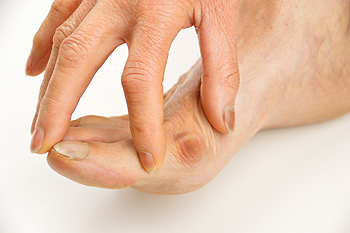 If you notice a small round area on your toe that is painful and appears to have thickened skin, you may have what is referred to as a corn. There are two types of corns that may develop for different reasons. A soft corn typically forms between the fourth and fifth toes, caused by excessive moisture, and it may often become infected. Hard corns develop on the side of the pinky toe or on the top of the toes. General causes for hard corns to occur consist of wearing shoes that are too tight or friction from any rubbing against the skin. If the socks that are worn are made of a non-absorbing material, sweat will accumulate between the toes, causing soft corns to develop. These conditions can be easily prevented by choosing to wear shoes and socks that have adequate room for the toes to move around in. It’s advised to schedule a consultation with a podiatrist for more information about corns and the proper treatment options for you.
If you notice a small round area on your toe that is painful and appears to have thickened skin, you may have what is referred to as a corn. There are two types of corns that may develop for different reasons. A soft corn typically forms between the fourth and fifth toes, caused by excessive moisture, and it may often become infected. Hard corns develop on the side of the pinky toe or on the top of the toes. General causes for hard corns to occur consist of wearing shoes that are too tight or friction from any rubbing against the skin. If the socks that are worn are made of a non-absorbing material, sweat will accumulate between the toes, causing soft corns to develop. These conditions can be easily prevented by choosing to wear shoes and socks that have adequate room for the toes to move around in. It’s advised to schedule a consultation with a podiatrist for more information about corns and the proper treatment options for you.
Corns can make walking very painful and should be treated immediately. If you have questions regarding your feet and ankles, contact Dr. Dushack of APEX Foot & Ankle Center. Our doctor will treat your foot and ankle needs.
Corns: What Are They? And How Do You Get Rid of Them?
Corns are thickened areas on the skin that can become painful. They are caused by excessive pressure and friction on the skin. Corns press into the deeper layers of the skin and are usually round in shape.
Ways to Prevent Corns
There are many ways to get rid of painful corns such as:
- Wearing properly fitting shoes that have been measured by a professional
- Wearing shoes that are not sharply pointed or have high heels
- Wearing only shoes that offer support
Treating Corns
Although most corns slowly disappear when the friction or pressure stops, this isn’t always the case. Consult with your podiatrist to determine the best treatment option for your case of corns.
If you have any questions please feel free to contact our offices located in Fort Myers and Naples, FL . We offer the newest diagnostic and treatment technologies for all your foot and ankle needs.
Read more about Corns: What Are They, and How Do You Get Rid of Them